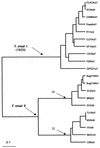Chemotherapy with benznidazole and itraconazole for mice infected with different Trypanosoma cruzi clonal genotypes
- PMID: 12499195
- PMCID: PMC149031
- DOI: 10.1128/AAC.47.1.223-230.2003
Chemotherapy with benznidazole and itraconazole for mice infected with different Trypanosoma cruzi clonal genotypes
Abstract
The benznidazole (BZ) and itraconazole (ITC) susceptibilities of a standard set of Trypanosoma cruzi natural stocks were evaluated during the acute phase and the chronic phase of experimental chagasic infection in BALB/c mice. Twenty laboratory-cloned stocks representative of the total phylogenetic diversity of T. cruzi, including genotypes 20 and 19 (T. cruzi I) and genotypes 39 and 32 (T. cruzi II), were analyzed. Our results demonstrate important differences among stocks that could be pointed out as markers of biological behavior. Members of the T. cruzi I group were highly resistant to both BZ and ITC, whereas members of the T. cruzi II group were partially resistant to both drugs, despite their susceptibilities to ITC during the chronic phase of infection. The resistance to BZ observed for T. cruzi I was mainly triggered by genotype 20 isolates, whereas resistance to ITC was due to both genotype 20 and 19 isolates. Two polar patterns of response to BZ observed for genotype 39 isolates had a major impact on the partial resistance pattern observed for members of the T. cruzi II group. Genotype 32 isolates showed a typical profile of susceptibility. The correlation between the response to treatment and phylogenetic classification of T. cruzi stocks was clearer for ITC than for BZ. In conclusion, the data presented show a correlation between phylogenetic divergence among T. cruzi stocks and their susceptibilities to chemotherapeutic agents in vivo. Our results warn of the necessity to take into account the lesser genetic subdivisions of T. cruzi stocks since the upper subdivisions (T. cruzi I and II) show a great deal of heterogeneity for in vivo drug susceptibility.
Figures







References
-
- Andrade, S. G., J. B. Magalhães, and A. L. Pontes. 1989. Terapêutica da fase crönica da infecção experimental pelo Trypanosoma cruzi com o benzonidazol e o nifurtimox. Rev. Soc. Bras. Med. Trop. 22:113-118. - PubMed
-
- Andrade, S. G., A. Rassi, J. B. Magalhães, F. Ferrioli Filho, and A. O. Luquetti. 1992. Specific chemotherapy of Chagas' disease: a comparison between the response in patients and experimental animals inoculated with the same strains. Trans. R. Soc. Trop. Med. Hyg. 86:624-626. - PubMed
-
- Andrade, S. G., and J. B. Magalhães. 1997. Biodemes and zymodemes of Trypanosoma cruzi strains: correlations with clinical data and experimental pathology. Rev. Soc. Bras. Med. Trop. 30:27-35. - PubMed
-
- Apt, B. W., X. Aguilera, A. Arribada, L. Gomez, M. A. Miles, and G. Widmer. 1987. Epidemiology of Chagas' disease in northern Chile: isoenzyme profiles of Trypanosoma cruzi from domestic and sylvatic transmission cycles and their association with cardiopathy. Am. J. Trop. Med. Hyg. 37:302-307. - PubMed
Publication types
MeSH terms
Substances
LinkOut - more resources
Full Text Sources
Medical

